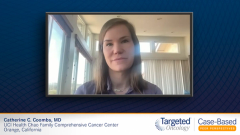
Unmet Needs and Clinical Pearls for Treating Relapsed/Refractory CLL
Catherine C. Coombs, MD, discusses unmet needs and offers advice for community oncologists treating patients with relapsed/refractory chronic lymphocytic leukemia.
Episodes in this series

Case: A 70-Year-Old Man with R/R Chronic Lymphocytic Leukemia (CLL)
- Patient AL is a 70 y/o man.
- PMH: T2DM and Hypertension (both well controlled with medication)
- SMH: Does not smoke or drink alcohol.
Clinical Presentation:
- In July 2022, AL was diagnosed with CLL and had been previously treated with venetoclax plus obinutuzumab upon initial diagnosis. Less than 6 months later, AL presented to his oncologist reporting an unresolved fever and increased fatigue.
Clinical Workup and Molecular Testing:
- Laboratory Findings:
- WBC: 120,000
- Hgb, 9.1 g/dL
- Platelets, 92 x 109/L
- Molecular Testing:
- Elevated serum beta-2-microglobulin
- Flow cytometry, CD5+, CD19+, CD23+
- IGHV/TP53 mutational status: unmutated
- FISH detect del(17p)
- ECOG PS 1
Disease Relapse and Treatment(s):
- Further disease progression was documented, and a joint decision was made to initiate AL on venetoclax plus rituximab.
- Venetoclax Dosing Ramp-Up Schedule
- Starting dose of 20 mg PO QD x 7 days, then weekly ramp up to 50 mg, 100 mg, 200 mg, and 400 mg PO daily. The recommended daily dose (400 mg) continues from week 5 and beyond for 24 months.
- Rituximab 375 mg/m2 on C1D1 (28-day cycle), then 500 mg/m2 on Day 1 for 5 cycles (completing after month 6).
- Venetoclax Dosing Ramp-Up Schedule
Transcript:
Catherine C. Coombs, MD: There are other unmet needs in relapsed and refractory CLL. One of the most significant is Richter’s transformation. This is an uncommon complication of CLL, but it probably occurs in around 5% of our patients. Unfortunately, our existing therapies for Richter’s perform very poorly and the median survival following a diagnosis of Richter’s is still under a year. So I would love to see further advances in this subset of patients because I think what we have right now is inadequate. As far as other unmet needs, there is always some proportion of patients who have intolerance. I do think that our newer BTK [Bruton tyrosine kinase] inhibitors are much more successful as far as rates of discontinuation due to adverse effects, but even with the rates that we have, which are better than what we had with ibrutinib, none of them are 0%. So I’d love to see more effective therapies but I’d also like to see patients who have intolerance be able to have success with similar drugs without such problems.
As far as recommendations for community oncologists treating CLL, the first one is that I think chemotherapy is largely a tool of the past. There is this small subset of patients who can attain durable progression-free survival, maybe even a cure, with FCR [fludarabine, cyclophosphamide and rituximab]. However, the toxicities of FCR, in my own view, make it a reason to almost never use it or not use it at all. This is now supported by a number of phase 3 trials demonstrating the superiority of our novel agents, including the[ECOG-ACRIN] trial, which showed prolonged survival in patients receiving ibrutinib as compared to FCR; the ALLIANCE trial (NCT01886872), which is showing a better PFS [progression-free survival] for ibrutinib as compared with BR [bendamustine plus rituximab]; and the CLL13 trial, which is showing better PFS for patients getting venetoclax-based regimens, particularly when paired with obinutuzumab.
So my first comment is chemoimmunotherapy is largely a tool of the past. The novel therapies are working quite well, but we can always improve matters, and I think the future in CLL hopefully will be moving towards more time-limited regimens. We have 2 different venetoclax time-limited regimens: venetoclax/obinutuzumab in the frontline setting, and VenR [venetoclax and rituximab] in the relapse setting. There are emerging data regarding the combination of BTK inhibitors and venetoclax that I think are also particularly exciting, especially in our higher-risk patients. This includes the GLOW (NCT03462719) and CAPTIVATE (NCT02910583) trials combining ibrutinib with venetoclax, but there are also studies looking at the newer generation of BTK inhibitors, such as acalabrutinib with venetoclax, that hopefully we’ll see more mature data in the coming years. The options are many, the disease is more treatable, and patients can have longer years of life and [better] quality of life, and I just hope that continues to improve.
Transcript edited for clarity.






































